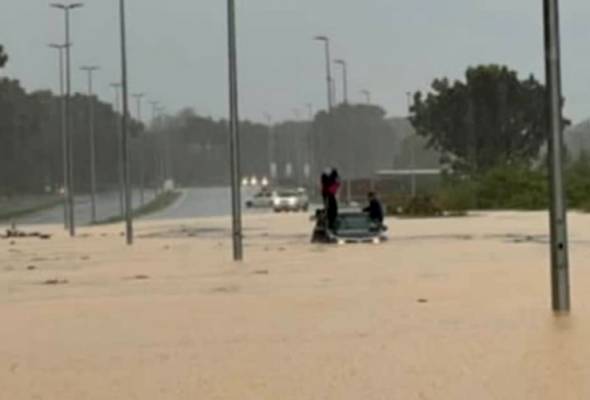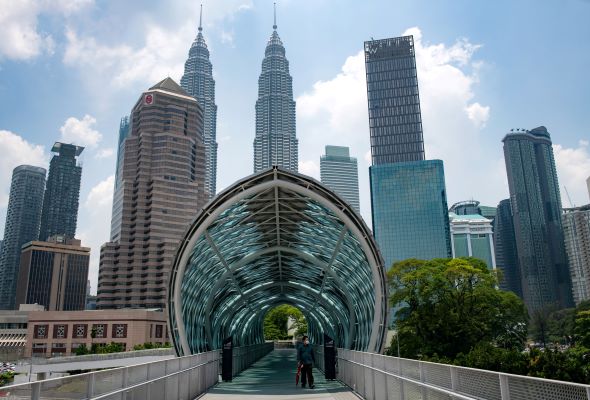
Published in Astro Awani & Asia News Today, image by Astro Awani.
Just as Malaysians has settled down to enjoying some form of normalcy after months of lockdown, heavy downpour in the Klang Valley, Negeri Sembilan, Perak, Kedah and Malacca during the past week has disrupted their daily routine.
Some citizens on a rush home after office hours experienced heavy traffic jams in some parts of the Klang Valley. As some roads either had sinkhole issues or car accidents, citizens who drove to commute in and out of work have had to spend more than 1.5 hours on average.
For residents staying in low-lying, flood-prone areas, they may not be able to drive to work if their vehicles were ruined by flooding. For homes that were filled with mud damaged electrical and home appliances, they may have to stay at temporary accommodation.
There is an increasing concern that residents who stay in flood-prone areas will experience flood again any time soon. EMIR Research has written an article on how extreme weather events would result in Malaysia facing the worst flood scenario by the end of the year.
According to the Malaysian Meteorological Department (MetMalaysia) Director-General Muhammad Helmi Abdullah, four to six episodes of significant heavy rain with possible flooding are expected to occur in the early phase of the North-East Monsoon from November until January 2022.
States which will experience heavy rainfall from November till December are Kelantan, Terengganu and Pahang. On the other hand, Johor, Sabah and Sarawak will experience heavy rain from December till January 2022.
However, this is not a new phenomenon in Malaysia.
Even before the emergence of the Covid-19 pandemic, the government spent billions of ringgit on flood mitigation measures alone.
The average annual cost of structural flood mitigation projects increased from about RM3 million under the 2nd Malaysia Plan (1971-1975) to approximately RM1 billion during the 11th Malaysia Plan (2016 -2020).
Recently, in response to flash floods in Kedah, Prime Minister Dato’ Sri Ismail Sabri Yaakob announced an immediate aid of RM75 million for repairs to the damaged infrastructure in Yan and Merbok following the Gunung Jerai mudflow in August.
Minister of Environment and Water Datuk Seri Tuan Ibrahim Tuan Man also revealed that the government has allocated over RM9 billion for almost 100 flood mitigation and urban drainage projects under the 12th Malaysia Plan (2021-2025) to manage the flood issue.
The Covid-19 pandemic not only limits our ability to absorb unexpected costs from flooding, but we also become more vulnerable in making ends meet due to the economic losses arising from the previous lockdown measures.
With a loss of jobs and income, the hardcore poor and B40 households who are staying in flood-prone areas would prioritise spending on basic needs (i.e., food, transport and shelter) – over clothing, education and health etc. – to cope with the rising cost of living.
Therefore, to address the recurring losses associated with multiple occurrences of flooding events in Malaysia, the Ministry of Environment and Water should increase efforts in the following initiatives:
- Introduce reforestation around low-lying, flood-prone areas to regulate water flows, act as barriers against storm surges and protect against erosion and mudslides;
- Introduce new market-based incentives for restoring degraded forests and increase the penalty for illegal logging;
- Regularly clearing solid pollutants that clog drains and rivers;
- Increase the carrying capacity of rivers and drains – either widening, deepening or both;
- Create a floodplain along the river to increase the water carrying capacity. During monsoon seasons, the floodplain could become a sacrificial piece of land to protect inhabited areas. In contrast, the floodplain could act as a water-dense, fertile, agricultural land where villagers could plant vegetables to generate their economic livelihoods during non-monsoon seasons;
- Install simple, custom-designed surveillance Internet of Things (IoT) modules at designated spots along the river. They can consist of a pollution detection sensor, a camera, a micro-controller, a transmitter and a rechargeable lithium-ion battery to prevent the river from clogging;
- Construct swales along major highways, roads and housing areas that are prone to flooding. Swales are shallow, broad and vegetated channels that could convey stormwater and treat run-off to reduce pollutants. In turn, the water does not collect on land and reduces the likelihood of flooding events;
- Install pedestrian pathways or cycling pathways by using permeable, highly-porous materials. Thereby, the water would seep through its surface and become groundwater or drain into drainage systems. With no more than 15-minute walking or cycling distance for most shops, parks, leisure facilities and residential areas, local citizens could enjoy nature, get fit, relax and release stress through cycling and jogging activities; and
- Create awareness campaigns and education programmes to promote a better understanding of environmental issues, especially disasters.
EMIR Research also urges the government to:
- Conduct periodic reviews (i.e., once in a month) of all short-, medium- and long-term flood mitigation plans together, ensuring all strategies are implemented within the specified time frames. The Department of Drainage and Irrigation (DID) and local city councils, for instance, should coordinate closely with the Ministry of Environment and Water;
- Plan for more evacuation centres at high-rise places that take into account the risk of Covid-19 in terms of ventilation and physical distancing, and ensure citizens are fully vaccinated;
- Continue developing effective early warning systems and disaster risk-reduction plans. For instance, MetMalaysia and National Disaster Management Agency (Nadma) could apply Geographic Information System (GIS) to produce a flood hazard map daily, identifying high flood risk areas. In turn, citizens who stay in low-lying areas could prepare to put their belongings in waterproof containers and relocate electrical appliances to higher ground in advance;
- Develop disaster-proof infrastructure to protect individuals and communities against natural hazards. The current administration could construct more large dams and build more high-capacity sewage treatment plants to restore polluted rivers to their original clean water quality condition;
- Allocate funding to conduct research and development (R&D) in the area of flood mitigation with the academic institutions, state governments and local authorities; and
- Adopt and adapt the US government’s approach in developing flood insurance programmes – protecting flood victims in Malaysia against losses from flooding. To ensure the premium is affordable, the government perhaps could introduce an “income-based subsidy” to subsidise B40 and M40 households. While letting T20 households pay the full flood insurance premium, the government could consider providing up to 80% and 50% subsidies for B40 and M40 households, respectively, which will help compensate them with the potential losses arising from damaged property.
Lastly, rather than purely relying on government effort in mitigating flood issues, all Malaysians must do their part not to throw any rubbish into the drain or river. The government could upgrade the existing drainage system without further delay and reduce the number of flood victim deaths and property damages.
Amanda Yeo is Research Analyst at EMIR Research, an independent think tank focused on strategic policy recommendations based on rigorous research.

